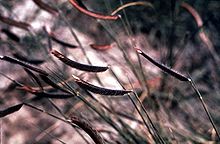Bouteloua gracilis
| Blue grama | |
|---|---|
 |
|
| Scientific classification | |
| Kingdom: | Plantae |
| (unranked): | Angiosperms |
| (unranked): | Monocots |
| (unranked): | Commelinids |
| Order: | Poales |
| Family: | Poaceae |
| Genus: | Bouteloua |
| Species: | B. gracilis |
| Binomial name | |
|
Bouteloua gracilis (Willd. ex Kunth) Lag. ex Griffiths |
|
Bouteloua gracilis (blue grama) is a long-lived, warm-season (C4) perennial grass, native to North America.
It is most commonly found from Alberta, Canada, east to Manitoba and south across the Rocky Mountains, Great Plains, and U.S. Midwest states, onto the northern Mexican Plateau in Mexico.
Blue grama accounts for most of the net primary productivity in the shortgrass prairie of the central and southern Great Plains. It is a green or greyish, low-growing, drought-tolerant grass with limited maintenance.
Blue grama grows on a wide array of topographic positions, and in a range of well-drained soil types, from fine to coarse-textured.
Blue grama has green to greyish leaves less than 3 millimetres (0.1 in) wide and 1 to 10 inches (25 to 250 mm) long. The overall height of the plant is 6 to 12 in (15 to 30 cm) at maturity.
The flowering stems (culms) are 7 to 18 inches (18 to 46 cm) long. There are typically two comb-like spikes, each with 20 to 90 spikelets, that extend out at a sharp angle from the flowering stem. Each spikelet is 5 to 6 mm (0.20 to 0.24 in) long. There is one fertile floret with a lemma (bract) 5 to 5.5 mm (0.20 to 0.22 in) long, with three short awns (bristles) at the tip, and one reduced sterile floret about 2 mm (0.08 in) long with three awns about 5 mm (0.2 in) long.
...
Wikipedia
